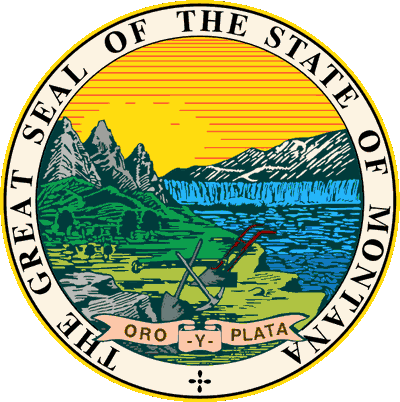

Montana Symbols
- » 50 States
- » Histories
- » State Symbols
- » Seals
Montana State Seal
Great Seal of the State of Montana

Adopted on February 9, 1865.
The Great Seal of the State of Montana was adopted in 1865, when Montana was a United States Territory. When it became a state in 1889, it was decided to use the same seal. In 1891, proposals were made to make changes or adopt a brand new seal. None of these proposals passed legislation. The outer ring of the seal contains the text "The Great Seal of the State of Montana". The inner circle depicts a landscape of mountains, plains and forests by the Great Falls on the Missouri River. A plow, a pick and a shovel are depicted on the front, representing the state's industry. The banner at the bottom of the seal reads the territorial motto of Oro y Plata, meaning "Gold and Silver" in Spanish
Montana Great Seal
Montana's first official symbol, its seal, has had a fascinating history. A Montana Territory legislative committee initially designed a seal in 1865. Francis M. Thompson chaired the committee and had what passed for expertise in the seal design business. He had engraved seals for the first mining districts on the ends of ax handles. Even he had to admit his work was not the most artistic, but it was the best at hand.
The special committee felt a seal should include all the essential elements in Montana's economy and future. A plow, shovel and pick would illustrate agricultural and mineral wealth. Surrounding these would be mountains, from which Montana took its name, the sun, and the Great Falls of the Missouri River. Interspersed on the field, delegates specified trees, buffalo, and other wild animals then in abundance. The seal would be two inches high and surrounded by the words THE SEAL OF THE TERRITORY OF MONTANA.
As a territorial motto, committee members favored "Gold and Silver." Someone thought the phrase would be nice in Spanish. The rest agreed. Unfortunately, no one knew Spanish very well and the committee's recommendation to the Legislature suggested "Oro el Plata." Someone caught the error later and made it grammatically correct: "Oro el Plata."
The abundant buffalos and other animals that were originally legislated dwindled to one lone buffalo. At another point, in 1876, the buffalo disappeared altogether. In 1887, mountains changed shape, the skies became cloudless, trees grew, and even the orientation of the sun change
When Montana became a state in 1889, the design of the seal was debated again. In 1891, proposals included the addition of 41 stars to represent the states, and the addition of new symbols, including Indians, buffalo, settlers and their wagons, a train, a stage coach, horses, sheep, cattle, a miner, a mill, a schoolhouse, a stream, and an irrigated field. Hold it!... As lawmakers continued this symbol debate, it became obvious that a mural might be a better choice for all these ideas. So, instead, the legislation failed, and it was decided that a better solution would be to use the existing territorial seal, and change the word "Territory" to "State".
But, when the engraver, G.R. Metten, was commissioned to produce the seal, he took it upon himself to reverse the flow of Great Falls and the Missouri River, move some trees, and reshape mountains.
2013 Montana Code Annotated
TITLE 1. GENERAL LAWS AND DEFINITIONS.
CHAPTER 1. GENERAL PROVISIONS.
Part 5. State Symbols - Official Designations.
SECTION 1-1-501.
1-1-501. Great seal. The great seal of the state is as follows: a central group representing a plow and a miner's pick and shovel; upon the right,
a representation of the Great Falls of the Missouri River; upon the left, mountain scenery; and underneath, the words "Oro
el Plata". The seal must be 2 1/2 inches in diameter and surrounded by these words, "The Great Seal of the State of Montana"
History: En. Sec. 1, p. 42, L. 1893; re-en. Sec. 1130, Pol. C. 1895; re-en. Sec. 430, Rev. C. 1907; re-en. Sec. 526, R.C.M. 1921; re-en. Sec. 526,
R.C.M. 1935; R.C.M. 1947, 19-111.






